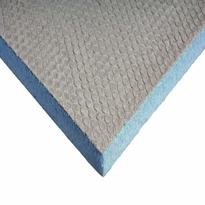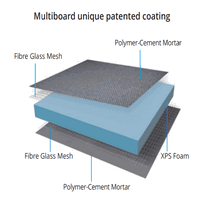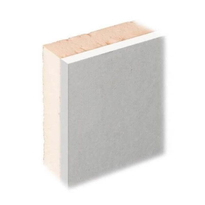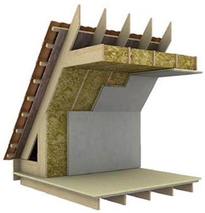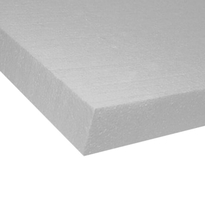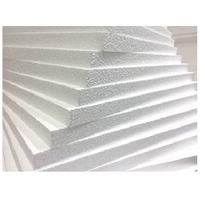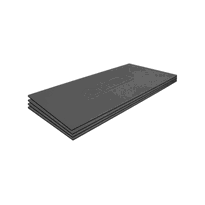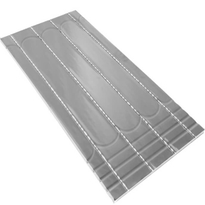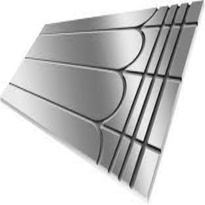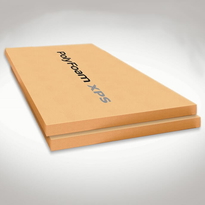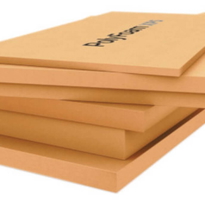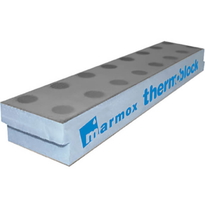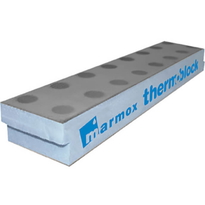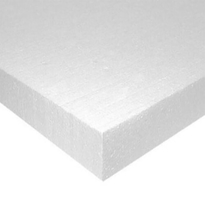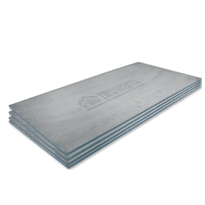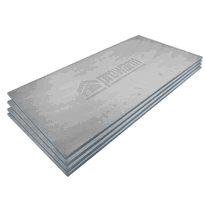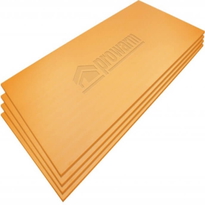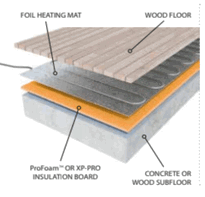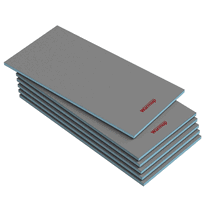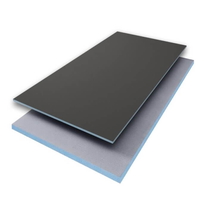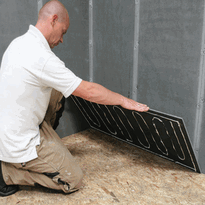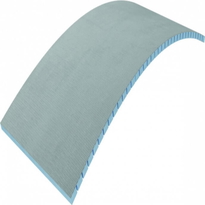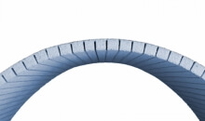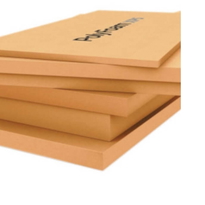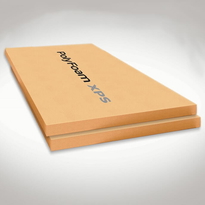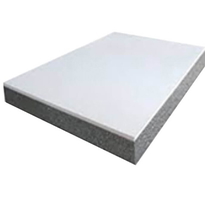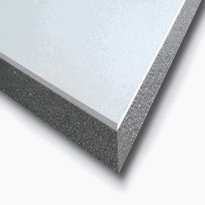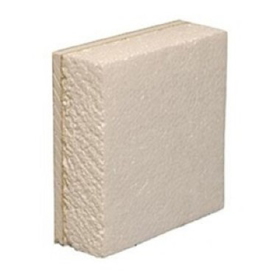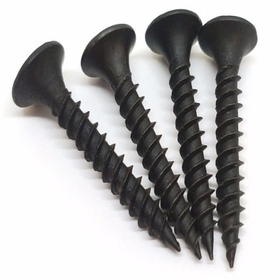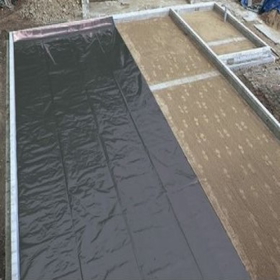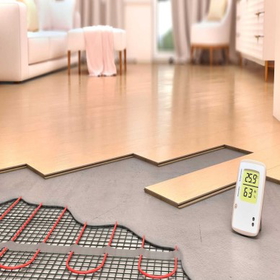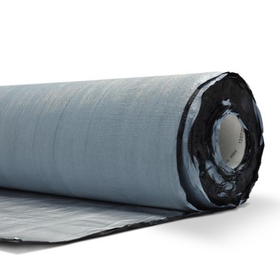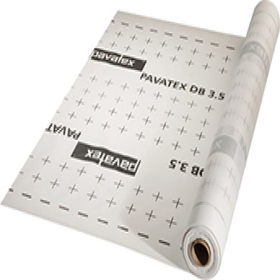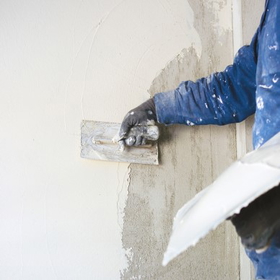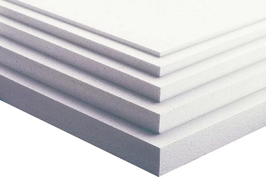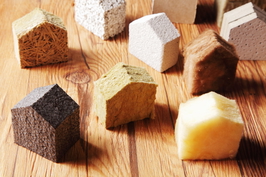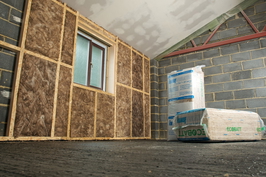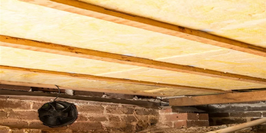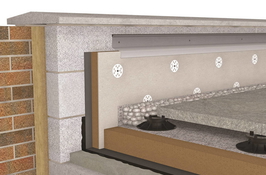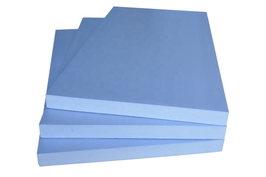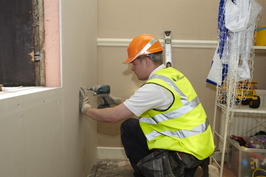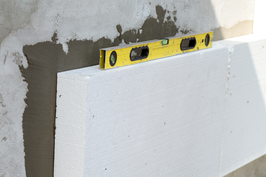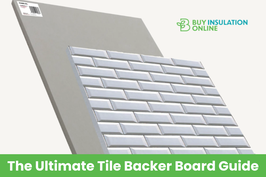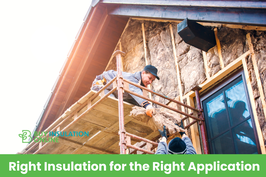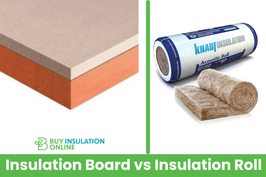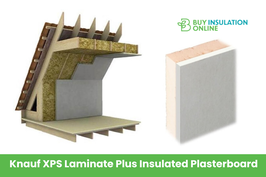Polystyrene Insulation Boards
Available in various thicknesses, such as 25mm, 50mm, and 100mm, polystyrene insulation boards help reduce heat loss, lower energy bills, and ensure compliance with UK building regulations. Expanded polystyrene insulation is moisture-resistant and long-lasting, offering reliable thermal performance for both new builds and retrofit projects.
Whether you're looking for a 25mm polystyrene insulation board for wall insulation or a 100mm expanded polystyrene insulation board for floor insulation, we have the right solution to help you insulate your property effectively. Browse our range of EPS products to find the perfect fit for your project and improve your property's energy efficiency today
Similar Categories
EPS (Expanded Polystyrene) boards were invented in the 1940s. This product’s development is attributed to the research of Fritz Stastny, a German scientist who discovered a way to expand the foam.
Polystyrene foam insulation boards quickly gained popularity due to their lightweight nature and insulating properties. This versatile product is used as insulation panels in construction and packaging while being an essential option for home or commercial building owners wanting to reduce energy use and their carbon footprint.
Since its invention, EPS board insulation has undergone improvements and advancements, including the development of different types with unique properties and densities.
What Are Polystyrene Insulation Boards?
Polystyrene insulation boards are a form of rigid insulation. It is constructed of a lightweight material from a manufacturing process that includes expanding and shaping polystyrene beads.
The best polystyrene boards are available in several sizes and thicknesses, ensuring each property receives the thermal insulation properties needed to achieve the desired result. This product is widely used for insulating roofs, walls, floors and other areas of buildings that could benefit from energy efficiency enhancements.
Polystyrene insulation sheets are placed between a building’s structural elements. This installation strategy provides a continuous insulating layer that works to prevent heat transfers.
Polystyrene wall insulation like Jablite and Stylite is extremely popular on our site and one of our best sellers.
Why Is Structural Insulation Important in Modern Homes?
Homes using polystyrene insulation boards can experience several positive outcomes when using today’s best products with low U-value ratings. These elements are critical to how the modern home supports one’s daily routine.
Energy Efficiency
Insulating the structural components, such as walls, roofs, and floors, helps to minimise heat transfer between the interior and exterior of a home.
Polystyrene sheets reduce the need for excessive heating or cooling, resulting in lower energy consumption and reduced utility bills.
Thermal Comfort Improvements
Structural insulation helps maintain a consistent and comfortable indoor temperature throughout the year.
It prevents heat loss during colder months and reduces heat gain during hotter periods. Once the upgrade is complete, you’ll notice fewer drafts and hot or cold zones.
Better Moisture Control
Moisture intrusion can lead to the rotting of structural components and damage to other building materials.
When structural insulation like EPS foam boards is used, a moisture barrier is formed, reducing the likelihood of condensation and moisture-related issues. The result is often the promotion of a healthier indoor environment.
Less Environmental Impact
Investing in structural insulation aligns with sustainable building practices. By reducing energy consumption and greenhouse gas emissions, it helps minimise the environmental impact of a home.
At the same time, it can reinforce the load-bearing elements, such as walls and roofs, improving their resistance to external forces like wind or seismic activity.
Benefits of Insulation EPS Foam Boards
Polystyrene insulation boards offer several potential advantages for those considering this upgrade or a new construction project. Here is a closer look at the potential benefits that could come when this product is correctly installed at your property.
1. Cost-Effective Choice
You’ll discover EPS foam boards are a cost-effective choice compared to many other insulation materials. Their low material and installation prices and energy savings over time make them an economical choice for many homeowners.
Rigid foam boards cost more when they have better thermal resistance ratings. XPS products could be priced over 50% higher because of this trait.
2. Installation Versatility 
The best expanded polystyrene insulation is available in various thicknesses and densities, offering versatility in applications. They can be easily cut and shaped to fit specific requirements, making them adaptable to different design needs.
EPS boards are widely used to insulate walls, roofs and floors in construction. They are easy to fit and install because of the product’s nature, making them an excellent choice for projects requiring flexibility.
3. Excellent Durability
These insulation EPS boards are highly durable and can withstand a range of weather conditions. They resist rot, decay, and degradation over time, ensuring long-term performance.
Generally, EPS foam boards can have a long lifespan when correctly used and maintained. Environmental conditions and product quality create variables, but some items are rated to last 30 years or more.
It is essential to review the insulation specifications of your preferred boards before installation to ensure your needs are met.
4. Lightweight Product
The best EPS foam boards are lightweight, which makes them easy to handle and install. This characteristic also contributes to your overall savings when reviewing transportation and labour expenses added to the manufacturing costs.
What Is the U-Value of Polystyrene Insulation Boards?
U-value is a measure of thermal conductivity, representing the rate of heat transfer through a material. Lower U-values indicate better insulation properties.
Expanded polystyrene foam boards are one of the most common types used for modern construction needs. Here are some examples of approximate U-value measurements to consider based on a product’s typical thickness.
- 25mm (1 inch) EPS board: U-value of around 0.038 W/m²K
- 50mm (2 inches) EPS board: U-value of around 0.019 W/m²K
- 100mm (4 inches) EPS board: U-value of around 0.009 W/m²K
Although XPS insulation offers a superior insulation rating to many EPS products, the outcomes are relatively similar at 100mm. An XPS board of this thickness has a U-value of approximately 0.0075 W/m²K compared to EPS’s 0.009 W/m²K.
It is essential to remember that these U-value figures are estimates. They can vary based on the specific manufacturer, product formulation and testing standards.
When selecting which polystyrene foam sheets to go for, reviewing the manufacturer’s specifications and technical data sheets for the most accurate U-value information is a good idea to ensure you’re investing in a product that makes sense for your needs.
Several other differences between EPS and XPS insulation exist. Reviewing them before proceeding with your project reduces the risk of installing something that doesn’t meet building regulations or codes.
What's the difference between expanding polystyrene and extruded polystyrene insulation?
Expanding polystyrene (EPS) and extruded polystyrene (XPS) are both types of rigid foam insulation made from polystyrene, a petroleum-based plastic. While they share some similarities, there are key differences between the two:
-
Manufacturing process:
- EPS: EPS is produced by expanding polystyrene beads in a mould using steam, which fuses the beads together and creates a closed-cell structure with air-filled voids. The process is relatively simple and cost-effective.
- XPS: XPS is made by mixing polystyrene resin with additives and then extruding the mixture through a shaping die, followed by a heating and cooling process. This results in a more uniform, closed-cell structure compared to EPS.
-
Density and strength:
- EPS: EPS typically has a lower density and slightly lower compressive strength compared to XPS. It is still a relatively strong material but may not be as suitable for applications requiring high load-bearing capabilities. EPS underfloor insulation like Stylite EPS70 is commonly used in the industry for insulating under concrete floors etc.
- XPS: XPS has a higher density and greater compressive strength, making it more durable and able to support heavier loads. This characteristic makes XPS a popular choice for applications where the insulation may be subjected to significant weight or pressure.
-
 Thermal performance:
Thermal performance:- EPS: Both EPS and XPS offer good thermal insulation properties. However, EPS may have a slightly lower R-value (a measure of thermal resistance) compared to XPS, meaning it may provide slightly lower insulation efficiency.
- XPS: XPS generally has a higher R-value than EPS, providing slightly better insulation performance for a given thickness.
-
Water absorption:
- EPS: EPS foam insulation is more susceptible to water absorption than XPS. While both materials are moisture-resistant, prolonged exposure to water can lead to a reduction in the insulation's performance in the case of EPS.
- XPS: Extruded polystyrene board is more water-resistant than EPS, and its closed-cell structure helps prevent moisture infiltration, making it more suitable for applications where water exposure is a concern.
-
Applications:
- EPS: EPS is commonly used in applications such as packaging, lightweight concrete forms, and cost-effective insulation in walls and roofs where water exposure is limited.
- XPS: XPS High density polystyrene insulation is often used in applications where higher strength, superior moisture resistance, and higher R-values are required. These include below-grade insulation, foundation insulation, and insulating flat roofs and walls where water exposure may be a concern.
In summary, both EPS and XPS are effective insulation materials, but the choice between them depends on the specific requirements of the application, including load-bearing capacity, thermal performance, and moisture exposure.
How to Install Polystyrene Sheet Insulation
Before starting the installation process, you’ll need a few tools and materials available to have a successful experience. That begins with having your preferred EPS insulation boards to use.
You’ll also want a measuring tape and a utility knife. EPS insulation needs an adhesive that works with the product. Some installation methods need screws and washers, and it might be helpful to have a caulking gun available if your glue comes in a tube.
Finally, it helps to have some protective gear to wear. You’ll want gloves and a dust mask. Many people find that having safety glasses is helpful.
Steps to Follow for Installing Polystyrene Insulation Boards
Once the tools and polystyrene insulation boards are available, you’ll be ready to follow these installation steps.:
1. Measure the area where you intend to install the EPS insulation boards. Take accurate readings and plan the layout to minimise the number of cuts needed.
2. Ensure the surface where the insulation will be applied is clean and dry. You want it to be free from dust, debris, and loose materials. It might be necessary to remove existing coverings or insulation.
3. Using a utility knife or an EPS insulation cutting tool, cut the boards to fit the dimensions of the installation area. Follow the principle of measuring twice and cutting once for the best results.
4. If your chosen installation method requires adhesive, apply it to the back of the EPS boards in a zigzag pattern or as the manufacturer recommends.
5. Press the expanded polystyrene insulation boards firmly onto the prepared surface, aligning them according to your planned layout. It helps to apply even pressure to ensure the installation is successful.
6. You might need to secure the insulation boards further with screws or washers. This step is required for vertical installations or when the product is applied to non-rigid surfaces.
Be careful you don't puncture any vapour barriers or membranes, especially in roofing applications.
7. Inspect the installation for gaps or joints between the insulation boards. Fill any you find with an appropriate sealant or insulation product to get a tight seal.
Once the insulation boards are securely in place, you can proceed with any additional steps required for your project, such as applying a vapour barrier or completing the wall assembly.
Why Polystyrene Insulation is Perfect for Underfloor Placement
If you have noise or energy loss issues because of a lack of insulation under your feet, it is worth considering polystyrene insulation boards for an underfloor placement.
Polystyrene foam board insulation has excellent compressive strength, which means it can withstand the weight of the floor and any loads placed on it without significant deformation. It achieves this result with its lightweight nature, keeping other load-bearing risks low.
This trait is crucial for underfloor settings where the product must maintain its effectiveness as it ages.
Polystyrene insulation is generally cheaper compared to other underfloor insulation materials. It offers good performance at a relatively low cost, making it an attractive option for underfloor insulation projects.
Since the boards are easy to cut into various shapes and sizes, you can easily use this product to fit almost any underfloor space.
Before starting a project requiring underfloor insulation, it helps review factors like building regulations and environmental conditions to ensure it is the best solution for your needs.
Can I Use Polystyrene Insulation Boards in Vehicles?
Although polystyrene insulation boards are lightweight and strong, they are not designed to withstand the vibrations and impacts that vehicles experience during operation.
If you own a campervan or a similar vehicle, you can cut this insulation to fill the awkward corners that other materials do not reach. EPS has numerous small air gaps that work to reduce heat loss.
Extruded polystyrene insulation boards have more durability because they are very rigid. It can be challenging to install inside a vehicle because of this trait.
Are There Any Concerns with Expanded Polystyrene Foam Insulation?
The advantages of using polystyrene insulation boards are clear. It delivers excellent results without experiencing thermal drift at an affordable price point.
You don’t have chlorofluorocarbons or hydrochlorofluorocarbons incorporated into the product during the manufacturing process. These boards have a proven record of success.
However, there are some potential disadvantages of polystyrene insulation to consider before proceeding. Here’s a closer look.
- Polystyrene boards get coated with HBCD, a bromine fire retardant that helps the product meet safety standards. It is considered persistent and bioaccumulative, meaning it does not easily break down in the environment and can accumulate in living organisms over time.
- It can absorb water because there can be spaces between the beads. This issue can attract infestations from ants and termites.
- The material does not biodegrade, although manufacturers are exploring recycled and bio-based alternatives to reduce the environmental impact of this product.
- These boards provide excellent thermal insulation but don’t offer as much thermal resistance as other materials. That means thicker boards might be necessary for your project.
- Polystyrene insulation boards are relatively brittle and can be easily damaged during handling. Careful planning is necessary during transport and installation to ensure the product works as intended.
- EPS foam boards can be recycled, but the product is not biodegradable. Recycling options aren’t available in most communities due to cost and management factors. Due to this, polystyrene is rarely recycled. You can reuse or repurpose the product after use for other purposes to reduce its presence in local waste management streams.
Although these concerns should receive careful consideration, expanded polystyrene boards are safe to use. It is an odourless and chemically inert product that will not give out fibres as you get with mineral wool insulation.
 Where to Buy Polystyrene Insulation?
Where to Buy Polystyrene Insulation?
For top-quality polystyrene insulation, visit Buy Insulation Online, your go-to ecommerce store. We offer a wide range of EPS and XPS products for various applications, including packaging, construction, and industry needs.
Our insulation provides excellent thermal efficiency, durability, and moisture resistance. With competitive prices, fast shipping, and outstanding customer service, buying from us is a breeze.
We proudly offer a wide selection of polystyrene insulation boards, catering to different needs and project requirements.
Our knowledgeable team is ready to assist you in choosing the right insulation solutions for your specific requirements, ensuring maximum efficiency and savings.
With our online platform, you can easily order from the comfort of your home or job site, and we'll deliver your insulation boards right to your doorstep, saving you time and effort. In-store pickup is available to save on delivery charges if you prefer
We source our insulation boards from trusted manufacturers, guaranteeing premium quality and reliable performance.
Experience the convenience of shopping from home while getting premium-grade insulation for exceptional results from the UK's no1 online insulation board supplier.
FAQ's
Q: What are polystyrene insulation boards?
A: Polystyrene insulation boards are rigid panels made from polystyrene foam. They are used as thermal insulation for walls, floors, and other applications due to their high performance and high compressive strength.
Q: What is the purpose of using polystyrene insulation boards?
A: The purpose of using polystyrene insulation boards is to provide thermal insulation to a building. They help reduce heat loss, improve energy efficiency, and create a comfortable indoor environment.
Q: What are the benefits of using polystyrene insulation boards?
A: The benefits of using polystyrene insulation boards include excellent thermal insulation properties, high compressive strength, lightweight construction, ease of installation, resistance to moisture and mould, and long-term durability.
Q: Where can I use polystyrene insulation boards?
A: Polystyrene insulation boards can be used in various insulation applications such as external wall insulation systems, inverted roofs, basements, and floors. They are suitable for both residential and commercial buildings.
Q: What sizes are available for polystyrene insulation boards?
A: Polystyrene insulation boards are commonly available in sizes of 2400mm x 1200mm (8ft x 4ft) and various thicknesses ranging from 30mm to larger sizes depending on the manufacturer.
Q: What are some popular brands of polystyrene insulation boards?
A: Some popular brands of polystyrene insulation boards include Jablite, Kingspan, SPI Stylite, and Kay-Metzeler. These brands offer a range of polystyrene insulation boards suitable for different insulation requirements.
Q: How do I install polystyrene insulation boards?
A: Polystyrene insulation boards can be installed by cutting them to size and fixing them to the desired surface using an appropriate adhesive or mechanical fixings. It is important to follow the manufacturer's guidelines for proper installation.
Q: Where can I buy polystyrene insulation boards?
A: Polystyrene insulation boards can be purchased from various building supply stores, online retailers, and directly from manufacturers or authorized distributors. It is recommended to compare prices and specifications before making a purchase.
Q: Are polystyrene insulation boards environmentally friendly?
A: Polystyrene insulation boards can be recycled and have a long lifespan, which makes them a relatively sustainable choice for insulation. However, it is important to dispose of them properly at the end of their life cycle.
Q: Can polystyrene insulation boards be used for floor insulation?
A: Yes, polystyrene insulation boards are commonly used for floor insulation. They provide effective thermal insulation, reducing heat loss through the floors and improving energy efficiency.
